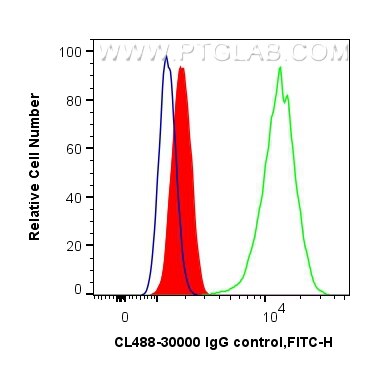Validation Data Gallery
Tested Applications
| Positive FC (Intra) detected in | HeLa cells |
Recommended dilution
| Application | Dilution |
|---|---|
| Flow Cytometry (FC) (INTRA) | FC (INTRA) : 0.20 ug per 10^6 cells in a 100 µl suspension |
| It is recommended that this reagent should be titrated in each testing system to obtain optimal results. | |
| Sample-dependent, Check data in validation data gallery. | |
Published Applications
| IF | See 1 publications below |
Product Information
CL488-30000 targets Rabbit IgG control in IF, FC (Intra) applications and shows reactivity with n/a samples.
| Tested Reactivity | n/a |
| Host / Isotype | Rabbit / IgG |
| Class | Polyclonal |
| Type | Antibody |
| Immunogen |
N/A 相同性解析による交差性が予測される生物種 |
| Full Name | Rabbit IgG control |
| Gene Symbol | |
| Gene ID (NCBI) | |
| RRID | AB_2919216 |
| Conjugate | CoraLite® Plus 488 Fluorescent Dye |
| Excitation/Emission maxima wavelengths | 493 nm / 522 nm |
| Form | |
| Form | Liquid |
| Purification Method | N/A |
| Storage Buffer | PBS with 50% glycerol, 0.05% Proclin300, 0.5% BSA{{ptg:BufferTemp}}7.3 |
| Storage Conditions | Store at -20°C. Avoid exposure to light. Stable for one year after shipment. Aliquoting is unnecessary for -20oC storage. |
Background Information
This product is Normal rabbit IgG (without immunized) which purified with Protein A. Normal Rabbit IgG is an isotype control antibody, which is used to estimate the non-specific binding of target primary antibodies due to Fc receptor binding or other protein-protein interactions. An isotype control antibody should have the same immunoglobulin type and be used at the same concentration as the test antibody.
Protocols
| Product Specific Protocols | |
|---|---|
| FC protocol for CL Plus 488 Rabbit IgG control antibody CL488-30000 | Download protocol |
| Standard Protocols | |
|---|---|
| Click here to view our Standard Protocols |
Publications
| Species | Application | Title |
|---|---|---|
PLoS One Activation of S1PR2 on macrophages and the hepatocyte S1PR2/RhoA/ROCK1/MLC2 pathway in vanishing bile duct syndrome | ||

